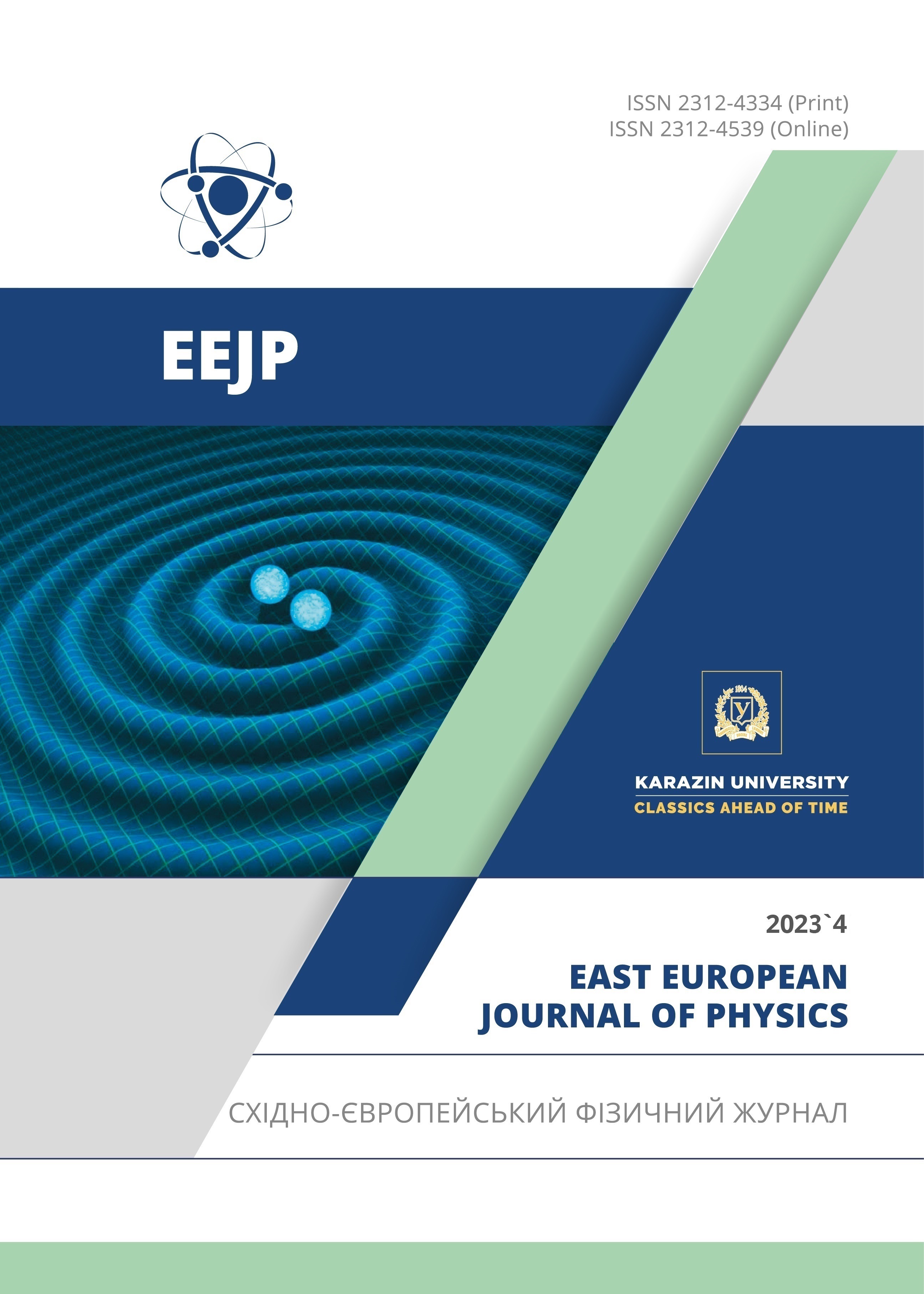Дослідження магнітних властивостей кремнію легованого рідкоземельними елементами
Анотація
У цій статті розглядаються електричні властивості кремнію, легованого рідкоземельними елементами (РЗЕ). Атоми рідкоземельних елементів (РЗЕ) дифундували на поверхню кремнієвої підкладки. Для вимірювання електричних параметрів були підготовлені зразки n-Si, n-Si<Lu>, n-Si<Er> і n-Si<Gd> та визначені їх електричні властивості за допомогою ефекту Холла, чотиризондового та термічного зондового методів. Дослідження проводили в інтервалі температур 77÷300 К. Омічний контакт зразків створювали сумішшю 1% Sb + 99% Au для вимірювання на приладі HMS500. Також питомий опір зразків у шарах, концентрацію носіїв заряду та рухливість зразків досліджували методом магнітоопору. Електричні параметри зразків вимірювали за допомогою системи вимірювання ефекту Холла Ecopia (HMS5000).
Завантаження
Посилання
Sh.B. Utamuradova, Kh.S. Daliev, E.K. Kalandarov, and Sh.Kh. Daliev, “Features of the behavior of lanthanum and hafnium atoms in silicon,” Technical Physics Letters, 32(6), 469–470 (2006). https://doi.org/10.1134/S1063785006060034
Kh.S. Daliev, Sh.B. Utamuradova, I.Kh. Khamidzhonov, A.Zh. Akbarov, I.K. Mirzairova, and Zh. Akimova, “Thermally Induced Deep Centers in Silicon Doped with Europium or Lanthanum,” Inorganic Materials, 37(5), 436–438 (2001). https://doi.org/10.1023/A:1017556212569
K.P. Abdurakhmanov, Sh.B. Utamuradova, Kh.S. Daliev, S.G. Tadjy-Aglaeva, and R.M. Érgashev, “Defect-formation processes in silicon doped with manganese and germanium,” Semiconductors, 32(6), 606–607 (1998). https://doi.org/10.1134/1.1187448
K.P. Abdurakhmanov, Kh.S. Daliev, Sh.B. Utamuradova, and N.Kh. Ochilova, “On defect formation in silicon with impurities of manganese and zinc,” Applied Solar Energy (English translation of Geliotekhnika), 34(2), 73–75 (1998).
Sh.B. Utamuradova, A.V. Stanchik, and D.A. Rakhmanov, “X-Ray Structural Investigations Of n-Si Irradiated with Protons,” East Eur. J. Phys. 2, 201 (2023). https://doi.org/10.26565/2312-4334-2023-2-21
Sh.B. Utamuradova, and D.A. Rakhmanov, “Effect of Holmium Impurity on the Processes of Radiation Defect Formation in n-Si,” Annals of the University of Craiova, Physics, 32, 132–136 (2022). https://cis01.central.ucv.ro/pauc/vol/2022_32/15_PAUC_2022_132_136.pdf
Sh.B. Utamuradova, Kh.S. Daliev, Sh.Kh. Daliev, and K.M. Fayzullaev, “Influence of chromium and iron atoms on defect formation processes in silicon,” Applied Physics, (6), 90 (2019). https://applphys.orion-ir.ru/appl-19/19-6/PF-19-6-90.pdf (in Russian)
Sh.B. Utamuradova, D.A. Rakhmanov, A.S. Doroshkevich, Z. Slavkova, and M.N. Ilyina, “Impedance spectroscopy of p-Si, p-Si irradiated with protons,” Advanced Physical Research, 5(1), 5–11 (2023). http://jomardpublishing.com/UploadFiles/Files/journals/APR/V5N1/Utamuradova_et_al.pdf
Sh.B. Utamuradova, Sh.Kh. Daliev, A.V. Stanchik, and D.A. Rakhmanov, “Raman spectroscopy of silicon, doped with platinum and irradiated by protons,” E3S Web of conferences, 402, 14014 (2023). https://www.e3s-conferences.org/articles/e3sconf/abs/2023/39/e3sconf_transsiberia2023_14014/e3sconf_transsiberia2023_14014.html
M.S. Sercheli, and C. Rettori, “Magnetic properties of a-Si films doped with rare-earth elements,” Physical review B, Condensed matter, 68, 174418 (2003). http://dx.doi.org/10.1103/PhysRevB.68.174418
J. Wen, N. Li, P. Lin, Y. Han, G. Chen, L. Bai, S. Guo, et al., “Electronic, magnetic and photocatalytic properties of Si doping in g-ZnO monolayer with point defects,” Physica E: Low-dimensional Systems and Nanostructures, 134, 114913 (2021). https://doi.org/10.1016/j.physe.2021.114913
J.H. Park, H. Takagi, K. Nishimura, H. Uchida, M. Inoue, J.H. Park, J.K. Cho, “Magneto-optic spatial light modulators driven by an electric field,” J. Appl. Phys. 93, 8525–8527 (2003). https://doi.org/10.1063/1.1557836
P.S. Kireev, Semiconductor Physics, 2nd ed. (Mir, Moscow, 1978).
A. Telegin, and Y. Sukhorukov, “Magnetic Semiconductors as Materials for Spintronics,” Magnetochemistry, 8(12), 173 (2022). https://doi.org/10.3390/magnetochemistry8120173
Y.P. Sukhorukov, N.N. Loshkareva, A.V. Telegin, E.V. Mostovshchikova, V.L. Kuznetsov, A.R. Kaul, A.N. Vinogradov, “IR radiation modulator based on the effect of magnetotransmission in lanthanum manganite operating near room temperature,” Tech. Phys. Lett. 29, 904–906 (2003). https://doi.org/10.1134/1.1631359
H.S. Nalva, Handbook of Thin Film Materials: Nanomaterials and Magnetic Thin Films, Vol. 5, (Academician Press, 2002). ISBN 9780125129084
Авторське право (c) 2023 Ходжакбар С. Далієв, Завкіддін Е. Бахронкулов, Джонібек Дж. Хамдамов

Цю роботу ліцензовано за Міжнародня ліцензія Creative Commons Attribution 4.0.
Автори, які публікуються у цьому журналі, погоджуються з наступними умовами:
- Автори залишають за собою право на авторство своєї роботи та передають журналу право першої публікації цієї роботи на умовах ліцензії Creative Commons Attribution License, котра дозволяє іншим особам вільно розповсюджувати опубліковану роботу з обов'язковим посиланням на авторів оригінальної роботи та першу публікацію роботи у цьому журналі.
- Автори мають право укладати самостійні додаткові угоди щодо неексклюзивного розповсюдження роботи у тому вигляді, в якому вона була опублікована цим журналом (наприклад, розміщувати роботу в електронному сховищі установи або публікувати у складі монографії), за умови збереження посилання на першу публікацію роботи у цьому журналі.
- Політика журналу дозволяє і заохочує розміщення авторами в мережі Інтернет (наприклад, у сховищах установ або на особистих веб-сайтах) рукопису роботи, як до подання цього рукопису до редакції, так і під час його редакційного опрацювання, оскільки це сприяє виникненню продуктивної наукової дискусії та позитивно позначається на оперативності та динаміці цитування опублікованої роботи (див. The Effect of Open Access).








